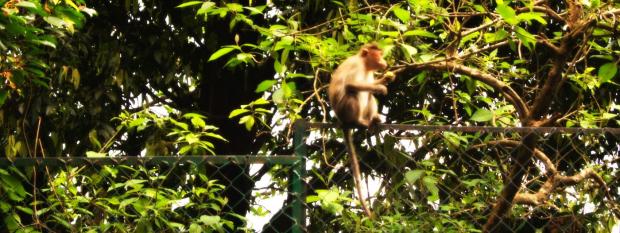
Researchers have, for the first time, reported in detail a little known source of water among great apes and Old World monkeys – a family of primates that inhabit the forests of Asia and Africa. The team, led by Prof Anindya Sinha of the National Institute of Advanced Studies, Bangalore, observed eight species of great apes and Old World monkeys (belonging to the Cercopithecidae family), drinking water accumulated in tree-holes.
Most monkeys and apes typically rely on water sources such as lakes, rivers or other water bodies located on land. In addition, they get their daily requirement of water through their diet. But sometimes, primates resort to other sources of water, such as water accumulated in tree-holes, to satisfy their thirst. While these behaviours have been well documented in the New World monkeys (found in North and South America), little is known about such behaviour among apes or Old World monkeys. This study found the use of this unusual water source in four apes—chimpanzee, Bornean orang-utan, siamang and western hoolock gibbon—and in four Old World monkeys—northern pig-tailed macaque, bonnet macaque, rhesus macaque and central Himalayan langur—found in a diverse range of habitats across south and southeast Asia.
Species that are primarily tree dwelling tend to access tree-holes more often than do their ground-dwelling cousins. To get to the water, the primates use a variety of techniques. The most common one is the dipping-and-licking method, in which individuals insert their hand into the hole and then bring their water-soaked hands to their mouth to drink. The western hoolock gibbons and the northern pig-tailed macaques in the Hollongapar Gibbon Sanctuary, Assam, and bonnet macaques in the Bandipur National Park, Karnataka, were found to have adopted this technique.
Some monkeys such as the central Himalayan langurs and rhesus macaques in Kedarnath Wildlife Sanctuary, Uttarakhand, were observed to manoeuvre their bodies to insert their heads to drink water directly from the tree-hole. Some may also scoop water into their mouth with their hands, as seen in Bornean orang-utans in Malaysia and siamangs in Indonesia, or use tools, such as leaves, to soak up the water.
There could be several different reasons for monkeys and apes having to resort to drinking water from high up in the tree-holes, dry habitats and seasonal water shortages being the most likely. Such behaviour may also help these primates avoid competition – having a stash of water high up in the trees helps avoid conflict with other individuals of the same species or with those of other species. It may also help them avoid running into predators lurking on the ground. Also, water from tree-holes may contain chemicals leached from the tree, which may offer benefits to these primates. Tannins in oak trees, for example, are known to have anti-parasitic activity.
While using water tucked away in tree-holes may seem like an obvious option, little had been known so far about such behaviours among Asian and African primates. Comparative studies of such behaviours, however, build our understanding of different species and their ecology. "Such synthetic, cross-species studies should be undertaken more regularly as they not only promote international cooperation in science, which is becoming increasingly cloistered but, more importantly, they foster a deeper understanding of the natural behaviour commonly shared by different, often uncommon, species and hence, the evolutionary basis of different aspects of their biology", says Prof Sinha on the need for such studies in the future.
Author and research information:
Prof Anindya Sinha <anindya.rana.sinha@gmail.com>, National Institute of Advanced Studies, Indian Institute of Science Campus, Bangalore.
This story is based on the paper “Watering holes: The use of arboreal sources of drinking water by Old World monkeys and apes”, Behavioural Processes 129.





